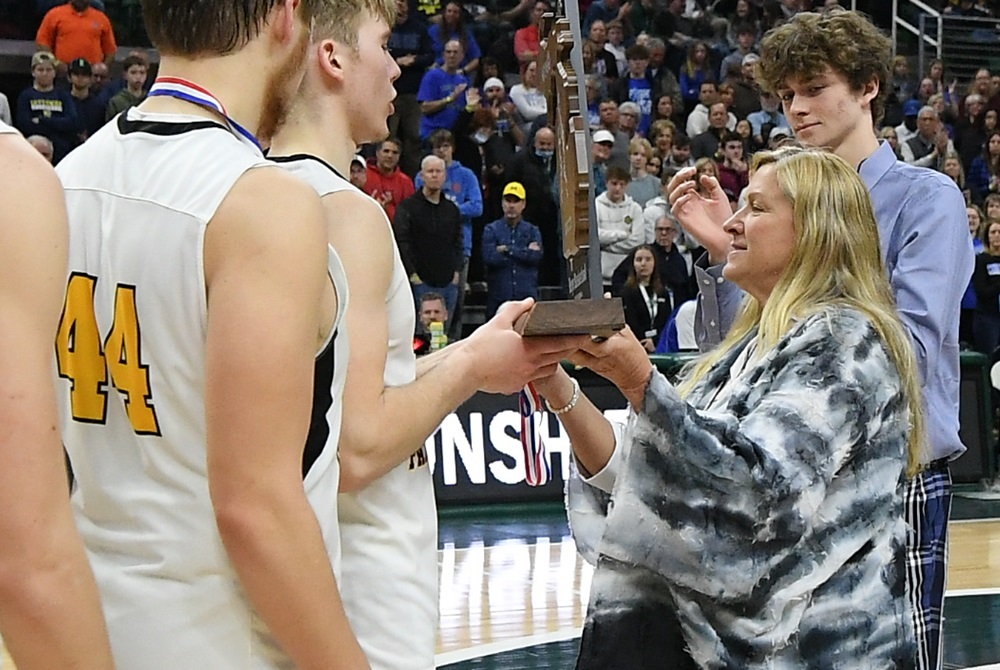
From the Director: Back to School
August 7, 2020
By Mark Uyl
MHSAA Executive Director
Since March 12, our world has been anything but normal. These times have tested most everything in life, and as summer turns toward fall, we find ourselves still with far more questions than answers. It has been said that an abnormal reaction to an abnormal situation is normal behavior.
Let me start with these abnormal times. I’ve had many conversations with administrators over the past month about the start of school and school sports. The one constant theme is these are anything but normal times. Many of these conversations have moved to the issue of schools starting the academic year virtually while considering whether or not to offer school sports opportunities this fall. Let me share the things that have been part of almost all conversations on this topic.
The loudest message I hear is kids are going to be playing sports this fall someplace. Period. If we believe that kids are going to take the fall off if school sports aren’t offered, we haven’t been paying much attention since May. Since that time, athletic activity has taken place in the club, travel, AAU and non-school space nearly every day. From first-hand experience, many of these events have implemented ZERO of the safety standards and protocols that businesses and schools have adopted for their plans of return. The non-school world generally has plowed ahead this summer with few-to-no rules, regulations, enforcement, oversight and accountability to anyone. If kids are going to be playing sports, our member schools are telling us that activity needs to be in the safest environment possible – which is with professional educators and trained coaches in our school sports world.
Schools are quick to point out that kids have been conditioning and training with school coaches in school-sponsored workouts most of the summer. We believe that the absence of virus outbreaks among our 749 high schools’ summer activities, involving thousands of kids, has been because schools have been following the return-to-activity plans. Districts have told us they can continue doing what they’ve been doing safely since June by following all COVID guidance and regulations we have put in place with government’s leadership and partnership.
Schools starting the year virtually are telling us they will use the lessons learned from the start of sports for when students return to campus later in the fall. School administrators have shared this view privately as this has become a highly-charged topic among various groups within our school communities. Sports allow schools to bring students back to campus in small, consistent and defined groups with the same adults working with those students each day. In school sports, there is little mixing of students from one sport with those students in another – making it much easier to monitor, track and trace kids when needed than if all students were in the buildings, hallways and classrooms all day. We hear from administrators that valuable lessons can be learned with athletics in August and September for a successful school start-up with students back on campus in October.
All of us share the fundamental belief that we must protect the health and safety of individuals first. This doesn’t include only COVID prevention measures, but also the mental health of teenage students and adults as well. In districts that are starting the school year online, they see athletics being the one shred of normalcy students, and staff members who choose to coach, will have during the fall. It’s a chance to safely interact with peers and get needed physical activity that hasn’t been happening for some kids since March. Health and safety has to include all facets of the individual, and more research is being shared each day about how mental health is becoming a critical issue. For many at-risk kids, sports is the one motivating factor to keep them in school and progressing toward graduation. Given the challenges of all online education for these at-risk kids, sports and the daily routine they bring perhaps would be more important for this group of students than ever before.
With no school sports, the affluent communities and families can navigate online learning during the day and then afford the non-school athletic opportunities that kids and families in less-affluent areas simply cannot. In many communities, school sports can provide opportunities and open doors that would not appear if kids become priced-out from participating and competing.
The past five months have been the most abnormal in a century. School sports being the one pathway back to school for students in our state – the one norm for this fall – run by professional educators who put kids first, would be an incredible boost to the physical and mental health of all of us. We believe that school sports can be done safely and smartly, and the MHSAA has developed plans that do just that. While the optics of sports taking place while waiting for in-person education is not what any of us prefer, we believe we must react to these abnormal times by thinking differently and looking at these unique times through a unique lens.
Trying to find one normal for our kids in these abnormal school days might just be the best thing we can do.

Care for Students Drove Forsythe Honoree Isom's Work for Nearly 40 Years
By
Geoff Kimmerly
MHSAA.com senior editor
March 10, 2025
For 39 years, Kris Isom poured herself into education and educational athletics as a teacher, coach, class advisor, athletic director, league president and advocate statewide as a remember of the Representative Council of the Michigan High School Athletic Association.
To celebrate nearly a lifetime of contributions – including several that continue to impact this state’s student-athletes – Isom has been selected as the 2025 honoree for the MHSAA’s Charles E. Forsythe Lifetime Achievement Award.
The annual award is in its 48th year and named after past MHSAA Executive Director Charles E. Forsythe, the Association's first full-time and longest-serving chief executive. Forsythe Award recipients are selected each year by the MHSAA Representative Council, based on an individual's outstanding contributions to the interscholastic athletics community at the local, regional and statewide levels. Isom will be honored during the MHSAA Boys Basketball Division 4 Final on March 15 at Michigan State University’s Breslin Student Events Center.
 Isom retired at the close of the 2023-24 school year after 38 at Adrian Madison and one at Clinton, where she attended high school and then began her teaching career before moving to Madison and becoming a pillar locally and statewide for nearly four decades.
Isom retired at the close of the 2023-24 school year after 38 at Adrian Madison and one at Clinton, where she attended high school and then began her teaching career before moving to Madison and becoming a pillar locally and statewide for nearly four decades.
In addition to serving as part of the MHSAA’s Council from 2008-23, Isom served as the president of the Tri-County Conference for more than two decades, on top of all the daily responsibilities that come with serving as a school athletic director. She also was one of the few athletic directors who also coached every year at some level, leading teams in basketball, volleyball, sideline cheer, softball and track & field.
“What I miss the most is the interaction with the kids. The coaching of course, but then everyday them coming into the office or giving me a hug or asking me what’s up,” Isom said. “It’s not always the athletes you intermingle with; it’s the kids in need, and even today when I see them or run into them, I get a hug or thank you, and that makes it all worth it.”
Isom has been recognized several times in the past for her contributions. She received the MHSAA’s Women In Sports Leadership Award in 2019, after previously being honored with an MHSAA Allen W. Bush Award in 2016 to recognize her behind-the-scenes contributions to school sports. She also was named Region 6 Athletic Director of the Year in 2000 by the Michigan Interscholastic Athletic Administrators Association (MIAAA).
During her time at Madison, she saw several of her school’s athletic programs enjoy success. Among recent highlights, Madison’s competitive cheer team finished Division 4 runner-up in 2022, the girls track & field team won a Lower Peninsula Division 3 Finals championship in 2017 and finished runner-up in 2016, and the 2016 volleyball team reached the Class C Semifinals with her daughter Rachel a contributor.
Kristen Isom indeed was a significant contributor to MHSAA work from a behind-the-scenes point of view, as she was a frequent host of District, Regional and Quarterfinal competitions and also MHSAA Coaches Advancement Program (CAP) sessions at her school. She also has been a longtime member of the MIAAA and National Interscholastic Athletic Administrators Association.
“For nearly four decades, Kristen Isom served as an excellent example of how to navigate the daily challenges of athletic administration while making a difference in the lives of her students and an impact on educational athletics on a larger scale as well,” said MHSAA executive director Mark Uyl. “She often showed a way forward as the MHSAA worked through complex topics, and always with the best interests of students first and foremost.”
A graduate of Clinton High School, Isom received her bachelor’s degree in science and teaching certification in physical education and health in 1984 from Michigan State University. She earned her master’s in elementary education in 1986 from Eastern Michigan University and also has completed graduate courses from Fresno Pacific University.
In addition to the MIAAA and NIAAA, Isom also has been a member of the Michigan Association for Health, Physical Education, Recreation and Dance (MAHPERD) and the Michigan State University Alumni Association. She’s been active with the Clinton United Church of Christ and Land & Lakes Ladies Club in various service efforts, and participated in local Meals on Wheels and roadside cleanup projects.
Isom is married to her husband Jerry, and she’s also maintained her real estate license for 30 years and is continuing in that work.
“Obviously (the Forsythe Award) being a high achievement, and being nominated by your peers, it doesn’t get any better than that. They know everything that goes into this job,” Isom said. “I think, like my daughter said, most people said you got paid to go watch games – that’s a perception many people have and that’s OK, because everybody’s job has ups and downs.
“But to have done something 38 years, at the same place, there must have been something you’re doing right, and you must have enjoyed it. And it’s hard to find that. It kinda makes you feel like everything you’ve done was worthwhile, that you made a difference in someone’s life.”
Past recipients
1978 - Brick Fowler, Port Huron; Paul Smarks, Warren
1979 - Earl Messner, Reed City; Howard Beatty, Saginaw
1980 - Max Carey, Freesoil
1981 - Steven Sluka, Grand Haven; Samuel Madden, Detroit
1982 - Ernest Buckholz, Mt. Clemens; T. Arthur Treloar, Petoskey
1983 - Leroy Dues, Detroit; Richard Maher, Sturgis
1984 - William Hart, Marquette; Donald Stamats, Caro
1985 - John Cotton, Farmington; Robert James, Warren
1986 - William Robinson, Detroit; Irving Soderland, Norway
1987 - Jack Streidl, Plainwell; Wayne Hellenga, Decatur
1988 - Jack Johnson, Dearborn; Alan Williams, North Adams
1989 - Walter Bazylewicz, Berkley; Dennis Kiley, Jackson
1990 - Webster Morrison, Pickford; Herbert Quade, Benton Harbor
1991 - Clifford Buckmaster, Petoskey; Donald Domke, Northville
1992 - William Maskill, Kalamazoo; Thomas G. McShannock, Muskegon
1993 - Roy A. Allen Jr., Detroit; John Duncan, Cedarville
1994 - Kermit Ambrose, Royal Oak
1995 - Bob Perry, Lowell
1996 - Charles H. Jones, Royal Oak
1997 - Michael A. Foster, Richland; Robert G. Grimes, Battle Creek
1998 - Lofton C. Greene, River Rouge; Joseph J. Todey, Essexville
1999 - Bernie Larson, Battle Creek
2000 - Blake Hagman, Kalamazoo; Jerry Cvengros, Escanaba
2001 - Norm Johnson, Bangor; George Lovich, Canton
2002 - John Fundukian, Novi
2003 - Ken Semelsberger, Port Huron
2004 - Marco Marcet, Frankenmuth
2005 - Jim Feldkamp, Troy
2006 - Dan McShannock, Midland; Dail Prucka, Monroe
2007 - Keith Eldred, Williamston; Tom Hickman, Spring Lake
2008 - Jamie Gent, Haslett; William Newkirk, Sanford Meridian
2009 - Paul Ellinger, Cheboygan
2010 - Rudy Godefroidt, Hemlock; Mike Boyd, Waterford
2011 - Eric C. Federico, Trenton
2012 - Bill Mick, Midland
2013 - Jim Gilmore, Tecumseh; Dave Hutton, Grandville
2014 - Dan Flynn, Escanaba
2015 - Hugh Matson, Saginaw
2016 - Gary Hice, Petoskey; Gina Mazzolini, Lansing
2017 - Chuck Nurek, Rochester Hills
2018 - Gary Ellis, Allegan
2019 - Jim Derocher, Negaunee; Fredrick J. Smith, Stevensville
2020 - Michael Garvey, Lawton
2021 – Leroy Hackley Jr., Byron Center; Patti Tibaldi, Traverse City
2022 – Bruce Horsch, Houghton
2023 – Karen Leinaar, Frankfort
2024 – Sean Jacques, Calumet
PHOTO Retired Adrian Madison athletic director Kristen Isom presents the Division 4 finalist trophy to Ewen-Trout Creek in 2022. (Photo by Andrew Frushour.)

